Navigation
Install the app
How to install the app on iOS
Follow along with the video below to see how to install our site as a web app on your home screen.
Note: This feature may not be available in some browsers.
More options
Style variation
You are using an out of date browser. It may not display this or other websites correctly.
You should upgrade or use an alternative browser.
You should upgrade or use an alternative browser.
Covid-19 News and Discussions
- Thread starter Yommie
- Start date
Yommie
Elite Member
- Oct 2, 2013
- 64,161
- 37,187
- Country of Origin

- Country of Residence

- Thread starter
- #82

Two local hospitals reverse COVID-19 vaccination policy for hiring: We want to hear from you
Were you or someone you know impacted by the hospital's mandatory COVID-19 vaccination policy like to share their story? If so, CTVBarrieNews.ca is interested in hearing your experience.
Two local hospitals reverse COVID-19 vaccination policy for hiring: We want to hear from you


Kim Phillips
CTVNews.ca Barrie Journalist
Follow | Contact
Updated Jan. 31, 2024 7:43 p.m. EST
Published Jan. 31, 2024 2:54 p.m. EST
Several hospital staff faced termination during the pandemic for failing to comply with the mandatory COVID-19 vaccination policy enforced at health centers throughout Ontario, which were in line with broader public health directives from the province.
However, the COVID-19 vaccination policy was recently reversed by two local hospitals, Royal Victoria Regional Health Centre in Barrie and Georgian Bay General Hospital in Midland, making it no longer a requirement for employment.
Were you or someone you know impacted by the hospital's mandatory COVID-19 vaccination policy like to share their story? If so, CTVBarrieNews.ca is interested in hearing your experience.
We invite you to share your story with us via email, providing your name, location, and phone number.
Yommie
Elite Member
- Oct 2, 2013
- 64,161
- 37,187
- Country of Origin

- Country of Residence

- Thread starter
- #83

Opinion | We Were Wrong About What Happened to America in 2020
The answer, only now coming into view, explains why that awful year still has us in its grip.
GUEST ESSAY
We Were Wrong About What Happened to America in 2020
Jan. 31, 2024
Credit...Chris W. Kim

- Share free access
Mr. Klinenberg is the author of the forthcoming book “2020: One City, Seven People, and the Year Everything Changed.”
Sign up for the Opinion Today newsletter Get expert analysis of the news and a guide to the big ideas shaping the world every weekday morning. Get it sent to your inbox.
Covid numbers recently climbed again. The U.S. Centers for Disease Control and Prevention once again reported monthly death tolls in the thousands. Mask mandates are back in New York City’s public medical facilities and nursing homes. The presidential race has kicked into gear and, just as in 2020, the stakes seem existential. It all makes me feel like I’m revisiting a past I never actually left.
I’m not the only one wrestling with that feeling. In other ways, 2020 seems like another lifetime. The pandemic ended; we went on with our lives. Yet by considerable margins, people still say they feel alienated, vulnerable, unsafe. It’s only now becoming clear how little we understood what the United States experienced during that unforgettable year and how deeply it shaped us.
I’ve come to think of our current condition as a kind of long Covid, a social disease that intensified a range of chronic problems and instilled the belief that the institutions we’d been taught to rely on are unworthy of our trust. The result is a durable crisis in American civic life. Just look at the election cycle we are about to fall into: It seems like the world turned upside down several times, and yet here we are facing the prospect of another contest between Joe Biden and Donald Trump, as though the country hasn’t moved forward an inch. Everything changed, and yet almost nothing changed at all.
Back in 2020, I learned about Daniel Presti, an affable and energetic 33-year-old, who was trying to build a new business called Mac’s Public House, just a few miles from his childhood home in Staten Island.
ADVERTISEMENT
SKIP ADVERTISEMENT
Thanks, he said, to the inexplicably slow pace of the New York State Liquor Authority, it took nearly a year to open, but he and his business partner, Keith McAlarney, used the time to make the bar the nicest it could be. The idea was to make Mac’s a local commons. No political talk. No news on TV. “Keith and I are the furthest from political you can find,” Mr. Presti would later tell me. “We’re not getting into it.”
In March, when Covid-19 hit New York City, the same state government that took ages to issue a liquor license needed just days to demand that the newly opened Mac’s cease operations. Mr. Presti understood the threat and accepted the decision. What he didn’t expect was that the pub would have to remain closed or restricted, on and off, for more than a year. Nor that, because his business was new, the government would offer so little financial support.
Mr. Presti spent the year in a state of anxiety and stress. No one in a position of power would listen to his pleas for assistance, and the rules for bars and restaurants kept changing.
His frustration was all too common. On a wide range of outcomes, including many that were less visible at the time, this country fared much worse during the Covid pandemic than comparable nations did. Distrust, division and disorganized leadership contributed to the scale of our negative health outcomes. As for our continuing distress, the standard explanation is a uniquely American loneliness. The surgeon general, Vivek Murthy, declared it an epidemic in its own right.
The truth, however, is there’s no good evidence that Americans are lonelier than ever. Our social patterns changed, of course. Yet a major recent poll shows that older Americans are now significantly less lonely than they were three years ago; a recent peer-reviewed study reports that middle-aged Americans describe themselves as less lonely than they were 20 years ago. Loneliness is more pervasive among younger Americans, but there too, the rates have also plummeted since 2020. Logically, we should be feeling better. Why can’t we shake this thing?
Editors’ Picks

The Women of ‘Feud: Capote vs. the Swans’ Are Birds of a Feather

Feeling Stuck? Here Are 5 Ways to Jumpstart Your Life.

Is Lip Balm Making My Chapped Lips Worse?
Because loneliness was never the core problem. It was, rather, the sense among so many different people that they’d been left to navigate the crisis on their own. How do you balance all the competing demands of health, money, sanity? Where do you get tests, masks, medicine? How do you go to work — or even work from home — when your kids can’t go to school?
The answer was always the same: Figure it out. Stimulus checks and small-business loans did help. But while other countries built trust and solidarity, America — both during and after 2020 — left millions to fend for themselves.
Now the Biden administration is flummoxed by why Americans don’t feel more optimistic despite all the good economic news, and some conservative groups are frustrated that Republican voters remain loyal to a candidate who has been charged with 91 felony counts. Voters are refusing to behave the way some are telling them would be rational. But the inequities that the pandemic laid bare have only deepened over time. For millions of Americans, distrust feels like the most rational state.
***
Over the past four years, I’ve gotten to know New Yorkers from every borough who felt abandoned by our core institutions when they needed a steady hand: a Bronx political aide who didn’t trust the vaccines she was promoting; an elementary teacher in Manhattan’s Chinatown whose students were viewed with suspicion by people afraid of the Asian flu; and Mr. Presti, who spent months looking for help or for answers while his work life and his dreams for the future fell apart. In November he and his partner kept their bar open past the 10 p.m. curfew mandated by the city. Soon after, they declared their business an “autonomous zone.” He went on Fox News to express his frustration about little guys getting clobbered by big government, being forced to sacrifice their livelihood. Fed up with institutions that wouldn’t help him, he grew distrustful of scientific authorities and impatient with fellow citizens who seemed too weak to question those in power. At some point, Mr. Presti started calling himself a freedom fighter.
The very different people I spoke with that year all had one thing in common: a feeling that in the wake of Covid, all the larger institutions they had been taught to trust had failed them. At the most precarious times in their lives, they found there was no system in place to help.
ADVERTISEMENT
SKIP ADVERTISEMENT
Nearly four years later, the situation is, if anything, worse.
Nursing homes across the country, where poor labor conditions were linked to higher Covid mortality levels, remain understaffed, leaving old, frail residents more vulnerable than they should be. Hunger and food insecurity remain wrenching emergencies. Students haven’t fully returned to school. Congress passed the Child Poverty Reduction Act of 2021, one of the most effective antipoverty measures in decades. Then a year later, Congress ended it, pushing some five million young people back down into extreme financial need.
When everything was uncertain and everyone’s future was on the line, we walked right up to the precipice of a moral breakthrough, and then we turned back.
Look at the way we all accustomed ourselves to the term “essential worker,” an ostensible term of respect that instead condemned people to work in manifestly dangerous conditions. The adoption of that term made visible something we now cannot unsee: In the United States the people we rely on most to keep our world functioning are the people we treated as disposable.
***
If social isolation wasn’t the core problem — most of the people I interviewed that year said they felt connected to friends and family, however far away they were — we might call the bigger problem structural isolation: abandoned by employers, deprived of shared purpose, denied care. The combined effect sent a strong message that individual lives weren’t worth as much anymore. (Did elected officials take to the airwaves and suggest that old people sacrifice themselves to save the economy? Yes, that really happened.)
People treated one another accordingly. We all remember the viral videos of people screaming at one another in supermarkets and on public transportation. Violent crime spiked. Even reckless driving surged — but it happened only in the United States.
ADVERTISEMENT
SKIP ADVERTISEMENT
The reasons for that American exceptionalism become only more urgent in an election year, when, as in a public health crisis, presidents can try to bring people together or try to turn them against one another. And they can convey a powerful message about whose lives matter.
By 2021, Daniel Presti had been arrested twice for defying city laws and had become something of a celebrity. When we spoke early that year, he told me that he and his partner were not “far-right guys.” But soon, he was on social media telling followers, “Don’t give up your guns. Ever.” and advising “ALL EYES ON ARIZONA AUDIT.” That October, when the mayor of New York City announced new vaccine mandates for city employees, he wrote: “We’re currently in a cold war and we are the soldiers with our very way of life under attack. Don’t expect anyone to come save you. We are the front lines. We are the defenders of liberty.”
At an early point in our conversations, he had friended me on Facebook. Then I found myself unfriended, and he stopped responding to my messages and calls. His last activity on Twitter was in December 2022, when he reposted an article shared by the right-wing pundit Dinesh D’Souza alleging that Michelle Obama helped get Mr. Trump kicked off Twitter.
***
A few weeks ago, I decided to reach out to Daniel Presti again. I wanted to learn about how things look to him these days and how he has rebuilt his life. We’re both New Yorkers; maybe now, with the bitter fights over bar closings and vaccine mandates many years behind us, we could find common ground again.
I sent Mr. Presti a couple of messages but got no reply. I called, with the same result. I tracked down his former business partner, who said he’d pass along my message. I thanked him and wished him luck.
ADVERTISEMENT
SKIP ADVERTISEMENT
I don’t know why Mr. Presti chose not to reply to me. He might just have more pressing matters to attend to. But the lack of resolution feels fitting, in a way, for a relationship that taught me so much about how this country failed people in 2020 and how those problems continue to this day. I hope he and I will reconnect someday down the line; for now, the silence is a dispiriting reminder that in America and even my own great city, social divisions have deepened. Today, as we barrel into the 2024 elections, the wounds of 2020 remain open, our conflicts unresolved. And the cold war Mr. Presti warned about may soon come to a boil.
Last edited:
Yommie
Elite Member
- Oct 2, 2013
- 64,161
- 37,187
- Country of Origin

- Country of Residence

- Thread starter
- #84

Will Ottawa Public Health stop updating its COVID-19 dashboard?
Ottawa Public Health is clarifying the confusion that has been circulating on social media around its plans to phase out its COVID-19 dashboard.
Will Ottawa Public Health stop updating its COVID-19 dashboard?


Toula Mazloum
CTV News Ottawa Digital Multi-Skilled Journalist
Follow | Contact
Updated Jan. 30, 2024 11:11 a.m. EST
Published Jan. 30, 2024 9:49 a.m. EST
Ottawa Public Health is clarifying the confusion that has been circulating on social media around its plans to phase out its COVID-19 dashboard.
While the current COVID-19 dashboard will be discontinued in February, the health unit pledges to continue to give updates about COVID-19 and respiratory illnesses circulating in the capital.
"It's worth noting that the data itself isn't going anywhere, either. Both the historical data from the COVID-19 dashboard and the latest raw data will still be available on our website," read a post on social media.
The health unit notes that in 2022 a whole new dashboard -- the Respiratory and Enteric Surveillance dashboard(opens in a new tab) -- was launched to track the activity of respiratory viruses in the city. The new dashboard gets updated every Wednesday.
Since then, the COVID-19 dashboard has slowly become redundant, as its data has been available in the new respiratory dashboard, says Ottawa Public Health.
The information shared in the respiratory dashboard is meant help people assess their risks of capturing diseases rather than just providing data. It also shows seasonal trends, allowing people to have an idea about what’s going on in their communities, explains the public health agency.
“At some point in February, the COVID-19 dashboard will no longer be refreshed each week. We haven't finalized exactly when it'll happen, but we'll be sure to let you know when it does,” Ottawa Public Health said on social media.
While the pandemic isn’t over yet, the health unit notes, people are asked to keep checking the respiratory dashboard, which will be updated on a weekly basis.
"And please keep assessing your risks. Keep staying up to date with your COVID-19 and flu vaccinations. Keep wearing well-fitted masks when needed. Keep using your layers. Take care, Ottawa," said Ottawa Public Health.
Yommie
Elite Member
- Oct 2, 2013
- 64,161
- 37,187
- Country of Origin

- Country of Residence

- Thread starter
- #88
COVID-19 kills 3 more in N.B., new variant JN.1 appears poised to become dominant
Flu kills 2, new cases drop back down to historical averages

Bobbi-Jean MacKinnon · CBC News · Posted: Jan 30, 2024 11:32 AM EST | Last Updated: January 30

A total of 1,185 people have now been hospitalized for or with COVID-19 since the respiratory season began on Aug. 27, 79 of whom required intensive care, while the flu has sent 387 to hospital, with 42 of them admitted to ICU. (Patrick Lacelle/Radio-Canada)
COVID-19 has killed three more New Brunswickers and a new subvariant, JN.1, appears to be on its way to taking over as the dominant strain in the province.
COVID-19 activity remains "moderate," according to Tuesday's Respiratory Watch report. Most indicators remained "stable" throughout the reporting period, Jan. 14 to Jan. 20, it says.
The flu has killed two more people, but influenza activity decreased during the reporting week, with the number of new cases dropping back to historical averages, the report shows.
The three people who died from COVID-19 were all aged 65 or older. Their deaths raise the pandemic death toll to at least 1,003, although the total is likely higher since the province has counted only people who die in hospital as COVID deaths since September.
Thirty-one people were hospitalized for or with the virus, three of whom required intensive care. That's down from 36 and six, respectively, in the previous report.
Among those admitted to hospital is a child under four. The others include four people aged 20 to 44, six aged 45 to 64, and 20 aged 65 or older.
The number of COVID outbreaks dropped to three from 14, according to the report, including one in a nursing home and two in "other facilities."
There were 82 new cases of COVID confirmed through PCR (polymerase chain reaction) lab tests, compared to 89 a week prior. The positivity rate — the percentage of PCR lab tests performed that produced a positive result — is seven per cent, unchanged.
About 2,600 more New Brunswickers rolled up their sleeves for the latest COVID vaccine in the past week, according to figures from the Department of Health.
A total of 138,662 COVID XBB.1.5 vaccines have been administered since Oct. 4.
Child under 4 among flu hospitalizations
The two people who died from the flu between Jan. 14 and Jan. 20 were both aged 65 or older, the Respiratory Watch report shows.The flu sent 22 people to hospital, down from 31 the previous week. Two of them were admitted to intensive care, down from four.
A child under four is among those hospitalized. There are also two people aged 20 to 44, five aged 45 to 64, and 14 aged 65 or older, the report shows.
Two lab-confirmed flu outbreaks have been declared, down from five.

The number of confirmed COVID-19 and flu cases in New Brunswick by week, Aug. 27, 2023 to Jan. 20, 2024, as illustrated by the gold and green bars, compared to the historical averages, illustrated by the gold and blue lines. (Government of New Brunswick)
There was also one "influenza-like illness" outbreak at a school, down from two.
School outbreaks are based on 10 per cent absenteeism in a school because of influenza-like illness symptoms, the report says. No other information has been released.
New lab-confirmed flu cases dropped nearly 41 per cent to 94. They were all influenza A (unsubtyped).
These raise the total number of cases since the season began on Aug. 27 to 2,129.
The positivity rate is eight per cent, down from 12.
As of Tuesday, 210,036 New Brunswickers have been vaccinated against the flu since Oct. 4, the Department of Health said.
JN.1 now represents more than 44% of cases
JN.1 has been detected in New Brunswick, Department of Health spokesperson Sean Hatchard confirmed.But he declined to say when, how many cases there are, or what percentage of sequenced cases it represents.
"New Brunswick isn't regularly releasing detailed breakdowns of COVID-19 sub-variants, as no other province in Atlantic Canada is doing so and there have been more than 100 genetic sequences of COVID-19 detected in the province since the beginning of the pandemic," he said in an emailed statement.
According to experts, while the strain has evolved like many of its predecessors to better evade the immune system and transmits more easily than other circulating variants, it has not shown any signs of more severe disease, and current vaccines are expected to provide protection.

BA.2.86 sublineages have now displaced recombinant XBB sublineages across the country and become the dominant lineage group, and JN.1 is the only one demonstrating consistent growth in Canada, according to the Public Health Agency of Canada. (U.S. National Institute of Allergy and Infectious Diseases)
The World Health Organization classified JN.1 as a "variant of interest," which is the second-highest rank after variant of concern, in December.
It is now the dominant strain in Canada. Data from the Public Health Agency of Canada shows the offshoot of BA.2.86 and its descendants accounted for more than 88 per cent of detections, as of Jan. 21.
The U.S. Centers for Disease Control and Prevention (CDC) has estimated JN.1 accounted for nearly 86 per cent of cases in the United States, as of Jan. 19. JN.1 remains the most widely circulating variant of SARS-CoV-2 in the United States and globally, the agency said.
JN.1 and its descendants were first detected in New Brunswick in November and now account for just over 44 per cent of sequenced cases in the province, as of Jan. 19, according to the volunteer group Protect Our Province New Brunswick (PoP NB), which aims to create easy-to-access information on COVID risks and protection measures.
That's up from about six per cent last month, according to the group.
PoP NB obtained the data through GISAID — an international non-profit project to share genome data on viruses, as contributed by the Vitalité Health Network's originating lab.
41 health-care workers off with COVID
Vitalité Health Network posted its monthly COVID report Tuesday afternoon, which shows 20 COVID-positive health-care workers have been removed from the job, as of Saturday. That's down from 72 infected employees in December.Vitalité has 10 hospitalized COVID patients, including one in intensive care.
Last month, there were 45 COVID-19 patients hospitalized, and none in ICU.
There is currently one hospital unit COVID outbreak — on the Dr. Georges-L.-Dumont University Hospital Centre's general surgical unit (4A).

Of Vitalité's 10 hospitalized COVID patients, four are here, at the Edmundston Regional Hospital. (Yves Levesque/Radio-Canada)
Horizon Health had 21 health-care workers off the job as of Saturday, after they tested positive for COVID-19, according to the network's weekly COVID dashboard. That's down from 30 COVID staff absences the previous week.
Horizon has 52 active COVID-19 hospitalizations, up from 46 last week. Four patients are in intensive care, unchanged.
There were still a number of Horizon hospital units with outbreaks, as of Tuesday, its website shows. They include:
- Moncton Hospital — cardiac step down, family practice and palliative care.
- Saint John Regional Hospital — family medicine.
- Dr. Everett Chalmers Regional Hospital — psychiatry.
- Oromocto Public Hospital — rehabilitation/geriatric.
Users who are viewing this thread
Total: 1 (members: 0, guests: 1)
Pakistan Defence Latest
-
Indian general praises professionalism of Pakistani peacekeepers in South Sudan (5 Viewers)
- Latest: Bossman
-
-
-
Country Watch Latest
-
-
-
-
China is experimenting with Starlink satellites to detect stealth aircraft (3 Viewers)
- Latest: AjayGhatak
Latest Posts
-
-
Grounded flight school student being held on no bond after vandalizing planes (2 Viewers)
- Latest: Lulldapull
-
-
